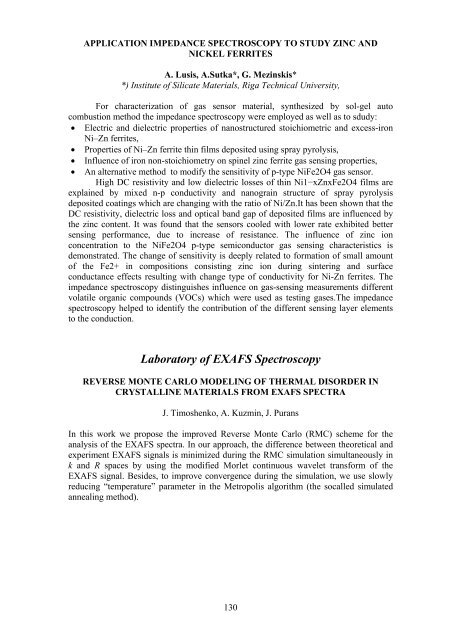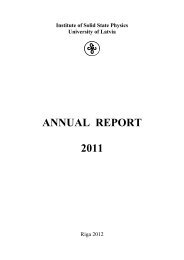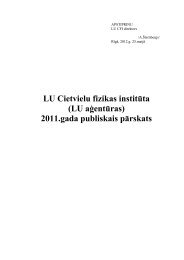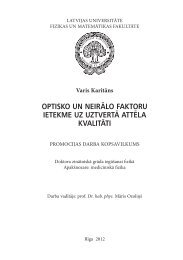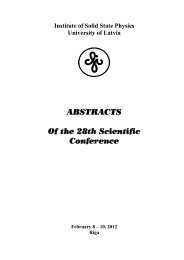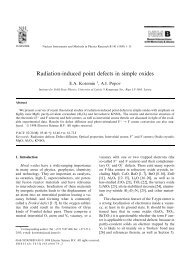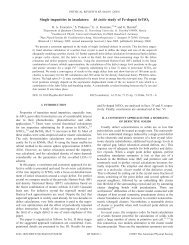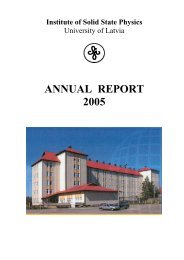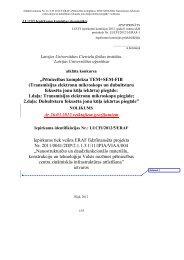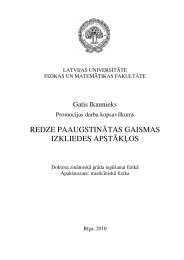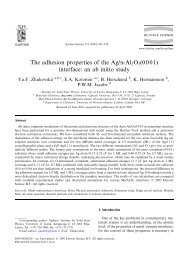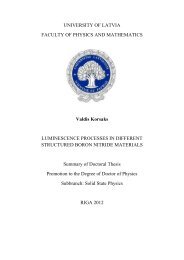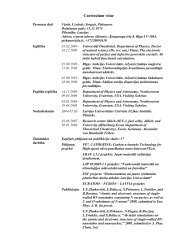Annual Report 2012 - Latvijas Universitātes Cietvielu fizikas institūts
Annual Report 2012 - Latvijas Universitātes Cietvielu fizikas institūts
Annual Report 2012 - Latvijas Universitātes Cietvielu fizikas institūts
Create successful ePaper yourself
Turn your PDF publications into a flip-book with our unique Google optimized e-Paper software.
APPLICATION IMPEDANCE SPECTROSCOPY TO STUDY ZINC AND<br />
NICKEL FERRITES<br />
A. Lusis, A.Sutka*, G. Mezinskis*<br />
*) Institute of Silicate Materials, Riga Technical University,<br />
For characterization of gas sensor material, synthesized by sol-gel auto<br />
combustion method the impedance spectroscopy were employed as well as to sdudy:<br />
• Electric and dielectric properties of nanostructured stoichiometric and excess-iron<br />
Ni–Zn ferrites,<br />
• Properties of Ni–Zn ferrite thin films deposited using spray pyrolysis,<br />
• Influence of iron non-stoichiometry on spinel zinc ferrite gas sensing properties,<br />
• An alternative method to modify the sensitivity of p-type NiFe2O4 gas sensor.<br />
High DC resistivity and low dielectric losses of thin Ni1−xZnxFe2O4 films are<br />
explained by mixed n-p conductivity and nanograin structure of spray pyrolysis<br />
deposited coatings which are changing with the ratio of Ni/Zn.It has been shown that the<br />
DC resistivity, dielectric loss and optical band gap of deposited films are influenced by<br />
the zinc content. It was found that the sensors cooled with lower rate exhibited better<br />
sensing performance, due to increase of resistance. The influence of zinc ion<br />
concentration to the NiFe2O4 p-type semiconductor gas sensing characteristics is<br />
demonstrated. The change of sensitivity is deeply related to formation of small amount<br />
of the Fe2+ in compositions consisting zinc ion during sintering and surface<br />
conductance effects resulting with change type of conductivity for Ni-Zn ferrites. The<br />
impedance spectroscopy distinguishes influence on gas-sensing measurements different<br />
volatile organic compounds (VOCs) which were used as testing gases.The impedance<br />
spectroscopy helped to identify the contribution of the different sensing layer elements<br />
to the conduction.<br />
Laboratory of EXAFS Spectroscopy<br />
REVERSE MONTE CARLO MODELING OF THERMAL DISORDER IN<br />
CRYSTALLINE MATERIALS FROM EXAFS SPECTRA<br />
J. Timoshenko, A. Kuzmin, J. Purans<br />
In this work we propose the improved Reverse Monte Carlo (RMC) scheme for the<br />
analysis of the EXAFS spectra. In our approach, the difference between theoretical and<br />
experiment EXAFS signals is minimized during the RMC simulation simultaneously in<br />
k and R spaces by using the modified Morlet continuous wavelet transform of the<br />
EXAFS signal. Besides, to improve convergence during the simulation, we use slowly<br />
reducing “temperature” parameter in the Metropolis algorithm (the socalled simulated<br />
annealing method).<br />
130


